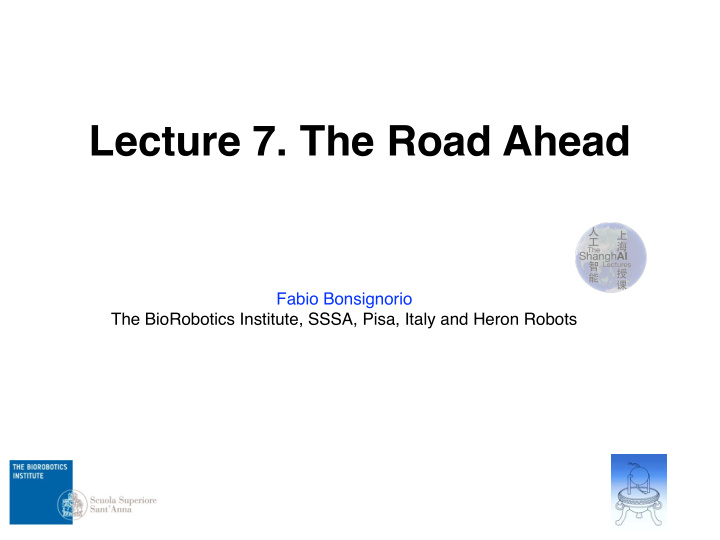



Lecture 7. The Road Ahead Fabio Bonsignorio The BioRobotics Institute, SSSA, Pisa, Italy and Heron Robots
Old ideas The part of the quote "or even of its own accord” is elsewhere translated as "or by seeing what to do in advance" etc. (you may find many translations). I think this is an important part of the quote, so it's good to go back to the original text: Aristotle uses the word " προαισθανό µ ενον " – proaisthanomenon this means literaly: pro = before, aisthanomenon = perceiving, apprehending, understanding, learning (any of these meanings in this order of frequency) in my view it is clearly a word that is attributed to intelligent, living agents....i.e. ones with cognitive abilities (!) personal communication, Dr. Katerina Pastra Research Fellow Language Technology Group Institute for Language and Speech Processing Athens, Greece 2
The “frame problem” Maintaining model of real world • the more detailed the harder • information acquisition • most changes: irrelevant to current situation 3
Summary of Dennett’s points obvious to humans, not obvious to robots (robot • only has symbolic model/representation of world) vast number of potential side effects, mostly • irrelevant distinction between relevant an irrelevant • inferences must test all • 4
Complete agents Masano Toda’s Fungus Eaters 5
Properties of embodied agents subject to the laws of physics • generation of sensory stimulation • through interaction with real world affect environment through behavior • complex dynamical systems • perform morphological computation • 6
Complex dynamical systems non-linear system - in contrast to a linear one —> Any idea? 7
Complex dynamical systems concepts: focus box 4.1, p. 93, “How the body …” dynamical systems, complex systems, non- • linear dynamics, chaos theory phase space • non-linear system — limited predictability, • sensitivity to initial conditions trajectory • 8
Design principles for intelligent systems Principle 1: Three-constituents principle Principle 2: Complete-agent principle Principle 3: Parallel, loosely coupled processes Principle 4: Sensory-motor coordination/ information self-structuring Principle 5: Cheap design Principle 6: Redundancy Principle 7: Ecological balance Principle 8: Value 9
Three-constituents principle define and design “ecological niche” • desired behaviors and tasks • design of agent itself • design stances scaffolding 10
Probabilistic Model Of Control Although it may seem strange only in recent times • the classical results from Shannon theory, have been applied to the modeling of control systems. As the complexity of control tasks namely in robotics • applications lead to an increase in the complexity of control programs, it becomes interesting to verify if, from a theoretical standpoint, there are limits to the information that a control program must manage in order to be able to control a given system. 11
Information self- structuring Experiments: Lungarella and Sporns , 2006 Mapping information flow in sensorimotor networks PLoS Computational Biology 12
Probabilistic Model Of Control Touchette, Lloyd (2004) Directed acyclic graphs representing a control process. (Upper left) Full control system with a sensor and an actuator. (Lower left) Shrinked Closed Loop diagram merging sensor and actuator, (Upper right) Reduced open loop diagram. (Lower right) Single actuation channel enacted by the controller's state C=c. 13
Models of ‘Morphological Computation’ + log W closed ( ) ≤ (I) K X closed W open Relation (I) links the complexity ('the length') of the control program of a physical element to the state available in closed loop and the non controlled condition. This show the benefits of designing stuctures whose 'basin of attractions' are close to the desired behaviors in the phase space. 14
Models of ‘Morphological Computation’ n ( ) ∑ Δ HN + Δ H i − Δ I ≤ I X ; C (II) i Relations (II) links the mutual information between the controlled variable and the controller to the information stored in the elements, the mutual information between them and the information stored in the network and accounts for the redundancies through the multi information term Δ I . 15
Snakebot see: Tanev et. al, IEEE TRO, 2005 16
Maybe not GOF Euclidean space? :-) see: Bonsignorio, Artificial Life, 2013 17
Synthetical methodology In order to understand (and design) the behaviors of this kind of systems … 18
Synthetical methodology We may build, and mathematically model, simpler ones … and design discriminating experiments … 19
Comparison and ranking When two systems are ‘equivalently’ ‘intelligent’ for a given set of tasks (e.g. DLA?) When a system ouperform another? There is a ‘sufficient statistics’ for a given set of tasks PARADIGM CLASHES We need a confidence estimation that … our self-driving car won’t provoke an accident.
Comparison and ranking When two systems are ‘equivalently’ ‘intelligent’ for a given set of tasks (e.g. DLA?) When a system ouperform another? There is a ‘sufficient statistics’ for a given set of tasks PARADIGM CLASHES PARADIGM CLASHES We need a confidence estimation that … our self-driving car won’t provoke an accident.
Thank you!
Thank you!
How to build a ‘new paradigm’ robot like the Cornell Ranger able to wave the hands like NAO? (and manipulate … ) a) Cornell ranger b) Nao walking down a ramp
Thank you for your attention! www.shanghailectures.org 25
Recommend
More recommend